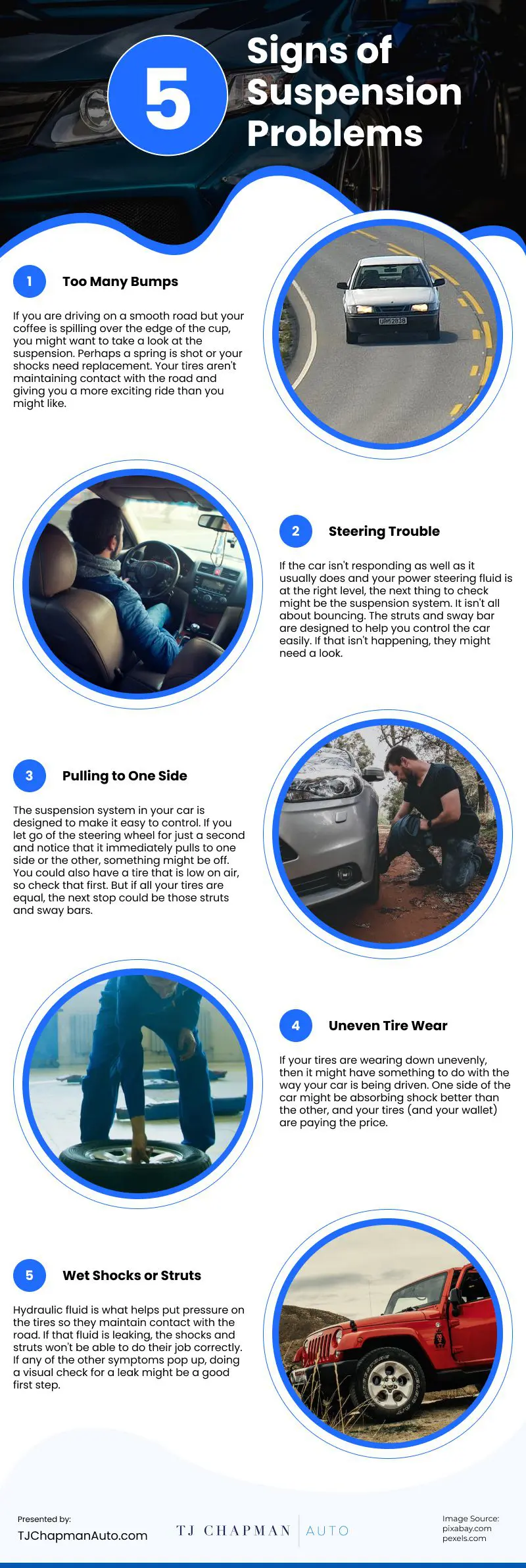
The suspension of your vehicle may be faulty if there is too much bouncing when you’re driving. Let’s look at the parts of a car suspension before detecting the signs of a suspension issue.
Chassis
This is the largest component of your car. The chassis is the skeleton of the car and is what everything rests or is fastened to.
Springs
The springs in your car’s suspension system prevent bounce. These steel coils are used to cushion the impact of driving over potholes, cracks, bumps, or curbs. The ride would be much more uncomfortable without springs.
Struts and Shocks
Shocks and struts are made to help keep the tires in contact with the road while springs work to absorb the shock of the road. The shocks move in tandem with the road’s bounce thanks to a piston and hydraulic fluid. When pressure is required to maintain the tires in contact with the ground, they release fluid to apply it to the tires. Struts typically deal with more than merely bouncing and are in the front of a car.
Sway Bar
A sturdy sway bar is important for larger vehicles. The sway bar’s purpose is to prevent sway. The weight of the car will wobble as you make turns. This can not only cause an uncomfortable lean, especially if you are in the RV’s back seat, but it can also result in uneven tire wear.
The sway evenly distributes the weight of the vehicle, applying pressure to the side that requires it to maintain the tires on the ground. It is made to withstand the normal twisting that a vehicle will naturally want to do when turning and navigating.
Indications of Suspension Issues
Let’s look at five typical signs that one or more of these components may have issues. Consult a professional if you notice any of these problems with your vehicle.
1. A Lot of Bumps
If your coffee is leaking over the side of the cup when you are traveling on a smooth road, check the suspension. Maybe a spring needs to be replaced or your shocks need to be upgraded. Your tires are losing traction with the pavement, which makes for a bumpier ride than you might prefer.
2. Steering Issues
The suspension system can be the next thing to check if the automobile isn’t responding as well as it usually does and if your power steering fluid is at the proper amount. Not everything involves bouncing. The struts and sway bar are made to make driving the car simple.
3. Dragging One Side
Something may be wrong with your suspension system if, after letting go of the wheel for a little period, you notice that it pulls to one side or the other. Check your tires first because you might also have one that needs air. However, those struts and sway bars might be the next port of call if all of your tires are equal.
4. Asymmetric Tire Wear
Maintaining equal pressure and weight in your tires is the responsibility of the suspension system. If the tread on your tires is wearing out unevenly, the suspension may be to blame. It’s possible that one side of the car can withstand shocks better than the other.
5. Wet Struts or Shocks
If you inspect your shocks and struts visually and they appear coated or wet, that could be hydraulic fluid and signal trouble. The hydraulic fluid assists in applying pressure to the tires so they may continue to make contact with the pavement. The shocks and struts won’t function properly if that fluid is leaking. A visual inspection for a leak may be a suitable first step if any of the other signs appear.
Once you are familiar with some of the major suspension system parts and what they do, you will feel more at ease asking the mechanic to check on the shocks, struts, or springs on your vehicle. After that, everything will go smoothly, or at least more so when driving.
source: https://blog.tjchapmanauto.com/is-that-bouncing-normal-five-signs-of-suspension-trouble/
Comments
Download this infographic.
